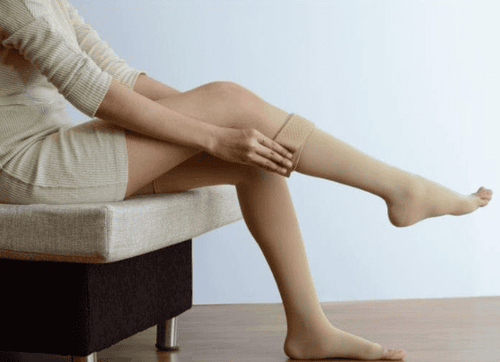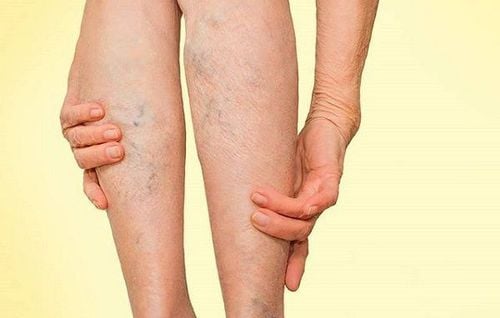This is an automatically translated article.
The article was consulted with Dr. Nguyen Van Duong - Interventional Cardiologist - Cardiovascular Center - Vinmec Central Park International General Hospital.Post-thrombotic syndrome is a common, sometimes disabling, deep vein thrombosis complication of lower extremities that reduces quality of life and is costly in care and treatment. Accordingly, the treatment of post-thrombotic complications requires perseverance, minimizing risk factors in order to strengthen the muscles in the legs, and avoid blood stagnation causing recurrent thrombosis.
1. Use Compression Therapy
Treatment of complications after deep vein thrombosis of the lower extremities has the main component using pressure therapy with the common representative being compression stockings. The effectiveness of pressure socks is when used daily with pressure from 20 to 30 mm Hg. Pressure socks should be put on in the morning and removed at bedtime or in the early evening. In cases where 20 to 30 mm Hg compression stockings do not adequately control symptoms of post-thrombotic syndrome, a higher pressure compression stocking will require replacement such as 30-40 mm Hg or 40-50 mm. Hg.Wearing compression stockings will quickly reduce the symptoms of post-thrombotic syndrome, improve the feeling of heaviness and discomfort and especially leg edema when walking or sitting for a long time. Thereby, as part of life, people wearing elastic compression stockings will quickly get used to and adapt to this therapy, restoring daily functions.
It is important that patients be educated about the use of compression stockings and the importance of compliance to maximize the benefits. Accordingly, this is the most effective therapy while having the least risk of harm.
The main contraindication to the use of compression stockings is if the patient has co-morbid symptoms of peripheral artery disease, as lower extremity artery occlusion may be aggravated by continuous compression stockings. long time.
In patients with moderate to severe complications of deep vein thrombosis whose symptoms are not adequately controlled with return compression stockings alone, the portable, battery-powered Venowave intermittent compression device can use instead. When used in combination with compression stockings and intermittent compression devices, patients' quality of life significantly improved and the severity of lower extremity DVT complications was reduced.
The remaining group of patients with symptoms of severe, intractable or edematous postthrombotic syndrome can use intermittent pneumatic compression devices (eg, used for 20-30 minutes at a time, 2 -3 times daily) for symptom relief. However, the drawback of this therapy is that it is cumbersome and expensive.

2. Medical treatment
Up to now, drugs used with indications for the treatment of complications after deep vein thrombosis of the lower extremities are still being studied and have not given clear value.However, initial drugs that have been highly evaluated and may have potential future clinical applications are:
Rutosides : Thought to decrease capillary filtration and microvascular permeability Defibrotide : Decreased release of plasminogen activator-1 inhibitor and up-regulated prostacyclin, prostaglandin E2, and thrombomodulin Hidrosmin : Mechanism of action unknown In addition, drug therapy is usually short-lived (eg, 8 weeks to months) and potential long-term side effects are unknown. Therefore, more rigorous studies using validated measures of clinically important outcomes, including quality of life, are still needed to assess safety, efficacy, and safety. Sustainability of drug treatments for this lower extremity deep vein thrombosis complication. Furthermore, there is no evidence that the use of diuretics is effective in the treatment of edema associated with post-thrombotic syndrome.
3. Lifestyle changes
Small trials have evaluated the effectiveness of exercise for the treatment of post-thrombotic syndrome. Specifically, patients with chronic venous insufficiency, half of whom had had a previous venous thrombosis, participated in a 6-month leg strengthening exercise program that improved function. calf muscles and leg muscle strength.Therefore, rehabilitation centers after deep vein thrombosis of the lower extremities encourage patients to participate in monthly exercise training programs. This is a set of exercises specifically designed to increase leg strength, leg flexibility, and overall cardiovascular health that will help improve the severity of post-thrombotic syndrome and both. quality of life without any significant side effects.
At the same time, additional advice on adjusting to a normal lifestyle at home or outside the gym also helps patients with chronic venous insufficiency reduce venous stasis is by staying active and avoiding a sedentary lifestyle; elevate your feet on a footrest when sitting or elevate your feet on a pillow when lying down; avoid prolonged exposure to heat as this can worsen the symptoms of swelling and heaviness in the legs; maintain a healthy, non-obese body weight; and use moisturizer to avoid dry skin and breakouts.

4. Venous ulcer care
Severe lower extremity deep vein thrombosis complications may include venous leg ulcers.Accordingly, patients with post-VTE should be treated with a multidisciplinary team approach, ideally including internists, dermatologists, vascular surgeons, and nurses wound care. At this time, venous ulcers in post-thrombotic syndrome are treated with compression therapy, which includes multicomponent compression, leg elevation, and local dressings.
In general, ulcers can be difficult to treat and often recur. In that case, surgery or endovascular procedure to treat deep vein reflux may be considered for some patients when conservative treatment has failed.
5. Treatment with surgery or endovascular intervention
Surgical or endovascular interventions such as deep vein valve repair, venous bypass and venous stenting have been used to treat patients with post-thrombotic syndrome, helping to reduce the manifestations of occlusion. deep vein thrombosis or venous regurgitation.In summary, the treatment of complications after deep vein thrombosis of the lower extremities requires multidisciplinary coordination; In which, compression therapy is the main treatment method, helping to increase blood flow in the veins and reduce uncomfortable symptoms for patients. In addition, the effective treatment of post-thrombotic syndrome is also combined with exercises to strengthen the muscles in the legs, persistence in venous ulcer care, as well as considering early surgical intervention if there is no response. response to conservative treatment.
Vinmec International General Hospital is one of the hospitals that not only ensures professional quality with a team of leading medical professionals, modern equipment and technology, but also stands out for its examination and consultation services. comprehensive and professional medical consultation and treatment; civilized, polite, safe and sterile medical examination and treatment space.
Please dial HOTLINE for more information or register for an appointment HERE. Download MyVinmec app to make appointments faster and to manage your bookings easily.
Reference source: ncbi.nlm.nih.gov













